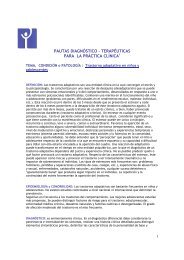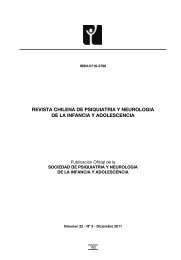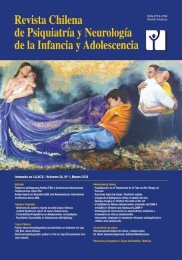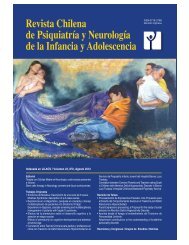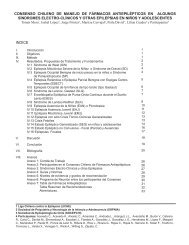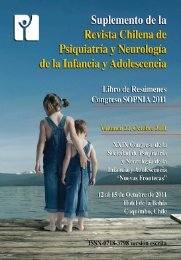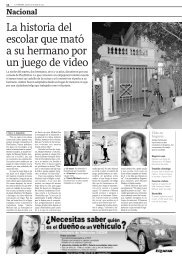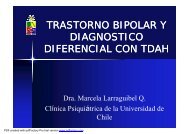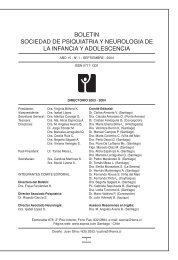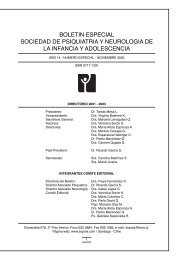revista chilena de psiquiatria y neurologia de la infancia
revista chilena de psiquiatria y neurologia de la infancia
revista chilena de psiquiatria y neurologia de la infancia
Create successful ePaper yourself
Turn your PDF publications into a flip-book with our unique Google optimized e-Paper software.
Año 18<br />
Nº 2<br />
Trastorno afectivo bipo<strong>la</strong>r: Evaluación <strong>de</strong> cambios funcionales cerebrales a partir <strong>de</strong> <strong>la</strong> técnica Neuro-SPECT<br />
rían diversas estructuras vincu<strong>la</strong>das a <strong>la</strong> modu<strong>la</strong>ción<br />
afectiva. Especialmente relevantes<br />
resultan <strong>la</strong> hiper-perfusión <strong>de</strong>l área ejecutiva<br />
(área 8, 9 y 10 <strong>de</strong> Brodman), Tá<strong>la</strong>mo, Caudado<br />
y núcleo Lentiforme como partes <strong>de</strong> un complejo<br />
circuito <strong>de</strong> estructuras neo-corticales y<br />
sub-cortico-límbicas. Estos resultados <strong>de</strong>ben<br />
compren<strong>de</strong>rse en el contexto <strong>de</strong> <strong>la</strong> teoría <strong>de</strong><br />
sincronía <strong>de</strong> fase e integración a gran esca<strong>la</strong><br />
<strong>de</strong> Vare<strong>la</strong> [36].<br />
Agra<strong>de</strong>cimientos: Los autores <strong>de</strong>sean agra<strong>de</strong>cer<br />
al Dr. Pedro Torres por evaluación <strong>de</strong><br />
algunos pacientes bipo<strong>la</strong>res presentados en<br />
este trabajo, igualmente, a <strong>la</strong> Sra. Lei<strong>la</strong> De Souza<br />
Coelho por asistencia técnica y a <strong>la</strong> Srta, Ximena<br />
Olivares por ayuda en <strong>la</strong> preparación <strong>de</strong><br />
este manuscrito.<br />
BIBLIOGRAFIA<br />
1. Ackenheil M (2001) Neurotransmitters and<br />
signal transduction processes in bipo<strong>la</strong>r<br />
affective disor<strong>de</strong>rs: a synopsis. Journal<br />
Affect Disord, 62: 101-111<br />
2. Aggleton JP (1993) The contribution of the<br />
amigda<strong>la</strong> to normal and abnormal emotional<br />
states. Trends Neurosci,16: 328-333<br />
3. Akiskal HS et al. (1979) Cyclothymic temperamental<br />
disor<strong>de</strong>rs. Psychiatr Clin North<br />
Am, 2:527-554.<br />
4. Akiskal HS (1996) The prevalent clinical<br />
spectrum of bipo<strong>la</strong>r disor<strong>de</strong>rs: Beyond<br />
DSM-IV. J Clin Psychopharmacol ,17 (suppl<br />
3):117S-122S<br />
5. Andreasen NC et al. (1987) Familial rates of<br />
affective disor<strong>de</strong>r. A report from the National<br />
Institute of Mental Health Col<strong>la</strong>borative<br />
Study. Arch Gen Psychiatry, 44:461-469<br />
6. Andrew L Stoll et al. (2000) Neuroimaging<br />
in bipo<strong>la</strong>r disor<strong>de</strong>r: what have we learned?<br />
Biol Psychiatry, 48: 505-517<br />
7. Baron et al. (1987) Genetic linkage between<br />
X-chromosome markers and bipo<strong>la</strong>r<br />
affective illness. Nature, 326:289-292<br />
8. Bebbington P, Ramana R (1995) The epi<strong>de</strong>miology<br />
of bipo<strong>la</strong>r affective disor<strong>de</strong>r.<br />
Soc Psychiatry Psychiatr Epi<strong>de</strong>miol, 30:<br />
279-292<br />
9. Bonne O et al. (1996) Cerebral hypoperfusion<br />
in medication resistant, <strong>de</strong>pressed patients<br />
assessed by Tc99HMPAO SPECT, J<br />
Affect Disord, 41: 163-171<br />
10. Carpenter MB (1991) Core text of Neuroanatomy.<br />
Baltimore: Williams and Wilkins.<br />
11. Clement S et al. (2003) Status of bipo<strong>la</strong>r disor<strong>de</strong>r<br />
research. Bibliometric study. British<br />
Journal of Psychiatry, 182: 148-152<br />
12. Cummings JL (1993) Frontal-subcortical<br />
circuits and human behavior. Arch Neurol,<br />
50: 873-880<br />
13. Damasio AR (1994) Descate’s Error: Emotion,<br />
Reason and the human brain. New<br />
York: Grosset-Putnam.<br />
14. Damasio AR (1999) The feeling of what happened.<br />
New York: Harcourt Brace.<br />
15. Delvenne V et al. (1990) Regional cerebral<br />
blood flow in patients with affective disor<strong>de</strong>rs.<br />
Br J Psychiatry, 157: 359-365<br />
16. Duncan J (November, 2001) An adaptive<br />
coding mo<strong>de</strong>l of neural function in prefrontal<br />
cortex. Nature, 2: 820-829<br />
17. Goodwin,G (2000) Perspectives for clinical<br />
research on bipo<strong>la</strong>r disor<strong>de</strong>rs in the new<br />
millennium. Bipo<strong>la</strong>r Disor<strong>de</strong>rs, 2: 302-303<br />
18. Hantouche EG et al. (1998) Systematic clinical<br />
methodology for validating bipo<strong>la</strong>r II<br />
disor<strong>de</strong>r. J Affect Disord, 50: 163-173<br />
19. Hirschfeld RMA et al. (2002) Lifetime prevalence<br />
of bipo<strong>la</strong>r I and II disor<strong>de</strong>rs in the<br />
United States. Presented at the 155th Annual<br />
Meeting of the American Psychiatric<br />
Association, Phi<strong>la</strong><strong>de</strong>lphia<br />
20. Ito et al. (1996) Hypoperfusion in the limbic<br />
system and prefrontal cortex in <strong>de</strong>pression:<br />
SPECT with anatomic standarization<br />
technique. J Nucl Med, 37:410-414<br />
21. Kan<strong>de</strong>l ER (2000) Principles of Neural<br />
Science.McGraw-Hill<br />
22. Kelsoe JR (2003) Arguments for the genetics<br />
basis of the bipo<strong>la</strong>r spectrum. Journal<br />
Affect Disord, 73:183-197<br />
23. Kessler RC et al. (1994) Lifetime and 12-<br />
month prevalence of DSM-IIIR psychiatric<br />
disor<strong>de</strong>rs in the United States: results from<br />
the National Comorbidity Survey. Arch Gen<br />
Psychiatry, 51: 8-19<br />
24. Kraepelin E (1921) Manic-Depressive Insanity<br />
and Paranoia. Edinburgh, ES Livingstone.<br />
25. Lish JD et al. (1994) The national Depressive<br />
and Manic-Depressive Association<br />
(NMDA) survey of bipo<strong>la</strong>r members. J<br />
Affect Disord, 31: 281-294.<br />
54



